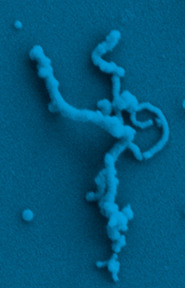 For the
first time, researchers have found direct evidence that microbes can create
templates for unique mineral growth. The discovery could inspire new avenues
for materials research, as well as for the search for evidence of life on Earth
and other planets.
For the
first time, researchers have found direct evidence that microbes can create
templates for unique mineral growth. The discovery could inspire new avenues
for materials research, as well as for the search for evidence of life on Earth
and other planets. This SEM image shows mineralized filaments, which have 2-nanometer-wide crystals at their cores. Researchers isolated these filaments from a tangled mass produced by a microbe. Image courtesy of G. De Stasio and B.H. Frazer.
Some microbes dwelling in caves and other unexpected ecosystems thrive on sulfur and other chemicals, leaving behind distinctive residues. But microbes from the Piquette Mine in Tennyson, Wis., seem to create an actual template to produce abnormally configured iron oxyhydroxide crystals in freshwater.
The resulting mineral, called akaganeite, usually only forms in saline environments, where plenty of chloride is available to stabilize the structure. But the microbe-associated form of the mineral is “very unusual,” says Jill Banfield, a geochemist at the University of California, Berkeley, and leader of the research team that published their results in the March 12 Science. The mineral has the same aspect ratio as human hair, only several nanometers across and many microns long. Usually, inorganic minerals grow relatively equally over all available surfaces, instead of elongated, like hair.
The researchers used a variety of methods, including high-resolution transmission electron microscopy, scanning electron microscopy and synchrotron spectromicroscopy. First, the team found that long strings of polymers, identified as polysaccharides, grew from the microbes’ cell surfaces. “The polymer threads accumulate a thick rind of iron oxyhydroxide, generating a spaghetti-like structure that is about 100 nanometers in diameter and many microns in length,” says Banfield. The core of the spaghetti is an akaganeite crystal a few nanometers wide. It would be very difficult to create this structure without life, Banfield says.
The site for the mineral templation is a carboxyl group in the polymers, says co-author Gelsomina De Stasio, a physicist at the University of Wisconsin, Madison, and co-director of the Synchrotron Radiation Center there. That negatively charged group binds a positively charged iron atom in the iron oxyhydroxide molecule — thus starting the templation mechanism. The polymer structure and self-assembly do the rest. “This is the first time that anybody could analyze the chemical interbonding of the inorganic and organic part at the molecular level” of a biomineralized structure, she says.
Biomineralization often is based on a templation mechanism in which an organic molecule dictates the structure of an inorganic one, De Stasio says. Such processes produce shells, bones and teeth, which resist fracture thousands of times more than similar but geologically formed minerals. Further molecular level studies might show how to “harness this system and synthesize future high-performance materials in the lab,” she says.
Organically created mineral structures also are important in the context of Mars exploration, Banfield says. The iron-oxidizing microbes her team studied (which are an as-yet unidentified species) have a “relatively simple metabolism [that] could be compatible with the environment on Mars,” she says. If researchers found such mineralized polymer structures on Mars, they would have direct evidence of organic activity. Early life on Earth may have left the same signature.
However, when looking for evidence of life, “we have to be really careful because there are abiotic means of making a lot of minerals that may appear biological,” says Steven Lower, a molecular biogeochemist at the Ohio State University in Columbus. Nevertheless, Lower says he is excited about the potential for creating new nanoscale materials in the lab.
Lower also says he is very intrigued by the researchers’ hypothesis as to why the microbes might create the minerals. The teams says that the microbes may harness the energy of protons released by nucleating iron hydroxides. “More work needs to be done to show that conclusively,” he says.
Naomi Lubick
Back to top

